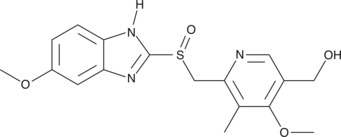Chemicals
Showing 6451–6600 of 41137 results
-
AKB48 is a pentyl indazole with structural similarity to JWH 018 adamantyl carboxamide (Item No. 9001193) and STS-135 (Item No. 11564), which are synthetic cannabinoids (CBs) with potential to be sold for recreational abuse.{22837} AKB48 N-(5-fluoropentyl) analog (Item No. 12065) is a structural derivative of AKB48 in which a fluorine atom has been added to the terminal carbon of the pentyl chain. This modification in other synthetic CBs typically increases the compound’s affinity for both CB receptors significantly.{18696} 5-fluoro AKB48 N-(4-hyroxypentyl) metabolite is an expected phase 1 metabolite of AKB48 N-(5-fluoropentyl) analog, based on the known metabolism of similar compounds.{19353} This product is intended for research and forensic applications.
Brand:CaymanSKU:-AKB48 is a pentyl indazole with structural similarity to JWH 018 adamantyl carboxamide (Item No. 9001193) and STS-135 (Item No. 11564), which are synthetic cannabinoids (CBs) with potential to be sold for recreational abuse.{22837} AKB48 N-(5-fluoropentyl) analog (Item No. 12065) is a structural derivative of AKB48 in which a fluorine atom has been added to the terminal carbon of the pentyl chain. This modification in other synthetic CBs typically increases the compound’s affinity for both CB receptors significantly.{18696} 5-fluoro AKB48 N-(4-hyroxypentyl) metabolite is an expected phase 1 metabolite of AKB48 N-(5-fluoropentyl) analog, based on the known metabolism of similar compounds.{19353} This product is intended for research and forensic applications.
Brand:CaymanSKU:-AKB48 is a pentyl indazole with structural similarity to JWH 018 adamantyl carboxamide (Item No. 9001193) and STS-135 (Item No. 11564), which are synthetic cannabinoids (CBs) with potential to be sold for recreational abuse.{22837} AKB48 N-(5-fluoropentyl) analog (Item No. 12065) is a structural derivative of AKB48 in which a fluorine atom has been added to the terminal carbon of the pentyl chain. This modification in other synthetic CBs typically increases the compound’s affinity for both CB receptors significantly.{18696} 5-fluoro AKB48 N-(4-hyroxypentyl) metabolite is an expected phase 1 metabolite of AKB48 N-(5-fluoropentyl) analog, based on the known metabolism of similar compounds.{19353} This product is intended for research and forensic applications.
Brand:CaymanSKU:-5-fluoro AMB metabolite 3 (Item No. 17893) is an analytical reference standard that is structurally similar to known synthetic cannabinoids. It is a metabolite of AMB (Item No. 15488) and 5-fluoro AMB (Item No. 15489).{32100} This product is intended for research and forensic applications.
Brand:CaymanSKU:-Available on backorder
5-fluoro AMB metabolite 3 (Item No. 17893) is an analytical reference standard that is structurally similar to known synthetic cannabinoids. It is a metabolite of AMB (Item No. 15488) and 5-fluoro AMB (Item No. 15489).{32100} This product is intended for research and forensic applications.
Brand:CaymanSKU:-Available on backorder
5-fluoro AMT (hydrochloride) (Item No. 32728) is an analytical reference standard categorized as a tryptamine.{60134} This product is intended for research and forensic applications.
Brand:CaymanSKU:32728 - 1 mgAvailable on backorder
5-fluoro AMT (hydrochloride) (Item No. 32728) is an analytical reference standard categorized as a tryptamine.{60134} This product is intended for research and forensic applications.
Brand:CaymanSKU:32728 - 5 mgAvailable on backorder
CUMYL-PICA (Item No. 17211) is a derivative of the aminoalkylindole cannabinoid AM2201 (Item No. 10707). 5-fluoro CUMYL-PICA is an analog of CUMYL-PICA characterized by the addition of an alkyl-terminal fluorine atom. The physiological and toxicological properties of this compound are not known. This product is intended for forensic and research applications.
Brand:CaymanSKU:-Out of stock
CUMYL-PICA (Item No. 17211) is a derivative of the aminoalkylindole cannabinoid AM2201 (Item No. 10707). 5-fluoro CUMYL-PICA is an analog of CUMYL-PICA characterized by the addition of an alkyl-terminal fluorine atom. The physiological and toxicological properties of this compound are not known. This product is intended for forensic and research applications.
Brand:CaymanSKU:-Out of stock
CUMYL-PICA (Item No. 17211) is a derivative of the aminoalkylindole cannabinoid AM2201 (Item No. 10707). 5-fluoro CUMYL-PICA is an analog of CUMYL-PICA characterized by the addition of an alkyl-terminal fluorine atom. The physiological and toxicological properties of this compound are not known. This product is intended for forensic and research applications.
Brand:CaymanSKU:-Out of stock
JWH 018 adamantyl is an analog of JWH 018, a mildly selective agonist of the peripheral cannabinoid (CB) receptor, where the naphthalene ring is substituted with an adamantyl group.{18291} Adamantyl substitutions provide structural rigidity and bulk. Though no biological activity has been reported for JWH 018 adamantyl, Δ8-THC analogs with adamantyl substituted for the carbon side chain demonstrate improved affinity and selectivity of central CB1 and peripheral CB2 binding.{13958} 5-fluoro JWH 018 adamantyl analog is a derivative of JWH 018 adamantyl (Item No. 9000799), having a fluorine atom at the terminal carbon of the pentyl chain. The physiological and toxicological properties of this compound are not known. This product is intended for forensic and research applications.
Brand:CaymanSKU:-JWH 018 adamantyl is an analog of JWH 018, a mildly selective agonist of the peripheral cannabinoid (CB) receptor, where the naphthalene ring is substituted with an adamantyl group.{18291} Adamantyl substitutions provide structural rigidity and bulk. Though no biological activity has been reported for JWH 018 adamantyl, Δ8-THC analogs with adamantyl substituted for the carbon side chain demonstrate improved affinity and selectivity of central CB1 and peripheral CB2 binding.{13958} 5-fluoro JWH 018 adamantyl analog is a derivative of JWH 018 adamantyl (Item No. 9000799), having a fluorine atom at the terminal carbon of the pentyl chain. The physiological and toxicological properties of this compound are not known. This product is intended for forensic and research applications.
Brand:CaymanSKU:-JWH 018 adamantyl is an analog of JWH 018, a mildly selective agonist of the peripheral cannabinoid (CB) receptor, where the naphthalene ring is substituted with an adamantyl group.{18291} Adamantyl substitutions provide structural rigidity and bulk. Though no biological activity has been reported for JWH 018 adamantyl, Δ8-THC analogs with adamantyl substituted for the carbon side chain demonstrate improved affinity and selectivity of central CB1 and peripheral CB2 binding.{13958} 5-fluoro JWH 018 adamantyl analog is a derivative of JWH 018 adamantyl (Item No. 9000799), having a fluorine atom at the terminal carbon of the pentyl chain. The physiological and toxicological properties of this compound are not known. This product is intended for forensic and research applications.
Brand:CaymanSKU:-MN-18 (Item No. 14817) is a synthetic cannabinoid modeled after AKB48 (APINACA, Item No. ISO00060), with the adamantyl group replaced by a naphthalenyl group. 5-fluoro MN-18 differs structurally from MN-18 by having fluorine at the terminal carbon of the pentyl chain. The physiological and toxicological properties of this compound are unknown. This product is intended for forensic and research applications.
Brand:CaymanSKU:-MN-18 (Item No. 14817) is a synthetic cannabinoid modeled after AKB48 (APINACA, Item No. ISO00060), with the adamantyl group replaced by a naphthalenyl group. 5-fluoro MN-18 differs structurally from MN-18 by having fluorine at the terminal carbon of the pentyl chain. The physiological and toxicological properties of this compound are unknown. This product is intended for forensic and research applications.
Brand:CaymanSKU:-MN-18 (Item No. 14817) is a synthetic cannabinoid modeled after AKB48 (APINACA, Item No. ISO00060), with the adamantyl group replaced by a naphthalenyl group. 5-fluoro MN-18 differs structurally from MN-18 by having fluorine at the terminal carbon of the pentyl chain. The physiological and toxicological properties of this compound are unknown. This product is intended for forensic and research applications.
Brand:CaymanSKU:-JWH 018 (Item No. 10900) is a potent synthetic cannabinoid (CB) which has been identified in smoking mixtures.{18291,19507} NNEI (Item No. 15001) is an analog of JWH 018 which differs by having an amide linker inserted between the naphthalene and ketone groups. 5-fluoro NNEI is a derivative of NNEI in which a fluorine atom has been added to the terminal carbon of the pentyl chain. This modification of other synthetic CBs typically increases the compound’s affinity for both CB receptors significantly.{18696} The physiological and toxicological properties of this compound are not known. This product is intended for forensic and research applications.
Brand:CaymanSKU:-JWH 018 (Item No. 10900) is a potent synthetic cannabinoid (CB) which has been identified in smoking mixtures.{18291,19507} NNEI (Item No. 15001) is an analog of JWH 018 which differs by having an amide linker inserted between the naphthalene and ketone groups. 5-fluoro NNEI is a derivative of NNEI in which a fluorine atom has been added to the terminal carbon of the pentyl chain. This modification of other synthetic CBs typically increases the compound’s affinity for both CB receptors significantly.{18696} The physiological and toxicological properties of this compound are not known. This product is intended for forensic and research applications.
Brand:CaymanSKU:-JWH 018 (Item No. 10900) is a potent synthetic cannabinoid (CB) which has been identified in smoking mixtures.{18291,19507} NNEI (Item No. 15001) is an analog of JWH 018 which differs by having an amide linker inserted between the naphthalene and ketone groups. 5-fluoro NNEI is a derivative of NNEI in which a fluorine atom has been added to the terminal carbon of the pentyl chain. This modification of other synthetic CBs typically increases the compound’s affinity for both CB receptors significantly.{18696} The physiological and toxicological properties of this compound are not known. This product is intended for forensic and research applications.
Brand:CaymanSKU:-NPB-22 (Item No. 15535) is a synthetic cannabinoid and analog of the regulated cannabimimetic JWH 018 (Item No. 10900). 5-fluoro NPB-22 is an analog of NPB-22 that differs by having a fluorine atom added to the terminal carbon of the alkyl chain. The physiological and toxicological properties of this compound have not been evaluated. This product is intended for forensic and research applications.
Brand:CaymanSKU:-NPB-22 (Item No. 15535) is a synthetic cannabinoid and analog of the regulated cannabimimetic JWH 018 (Item No. 10900). 5-fluoro NPB-22 is an analog of NPB-22 that differs by having a fluorine atom added to the terminal carbon of the alkyl chain. The physiological and toxicological properties of this compound have not been evaluated. This product is intended for forensic and research applications.
Brand:CaymanSKU:-NPB-22 (Item No. 15535) is a synthetic cannabinoid and analog of the regulated cannabimimetic JWH 018 (Item No. 10900). 5-fluoro NPB-22 is an analog of NPB-22 that differs by having a fluorine atom added to the terminal carbon of the alkyl chain. The physiological and toxicological properties of this compound have not been evaluated. This product is intended for forensic and research applications.
Brand:CaymanSKU:-5-fluoro Orotic acid (5-FOA) is used to detect URA3 gene expression in yeast molecular genetic constructs.{28301} Yeast with an active URA3 gene, which encodes orotine-5′-monophosphate decarboxylase, converts 5-FOA to fluorodeoxyuridine, which is toxic to cells. Resistant strains of yeast that carry a mutation in the URA3 gene grow in the presence of 5-FOA if the media is supplemented with uracil.
Brand:CaymanSKU:-Available on backorder
5-fluoro Orotic acid (5-FOA) is used to detect URA3 gene expression in yeast molecular genetic constructs.{28301} Yeast with an active URA3 gene, which encodes orotine-5′-monophosphate decarboxylase, converts 5-FOA to fluorodeoxyuridine, which is toxic to cells. Resistant strains of yeast that carry a mutation in the URA3 gene grow in the presence of 5-FOA if the media is supplemented with uracil.
Brand:CaymanSKU:-Available on backorder
5-fluoro phenyl-PICA (Item No. 23924) is an analytical reference standard categorized as a synthetic cannabinoid.{29528} This product is intended for research and forensic applications.
Brand:CaymanSKU:23924 - 1 mgAvailable on backorder
5-fluoro phenyl-PICA (Item No. 23924) is an analytical reference standard categorized as a synthetic cannabinoid.{29528} This product is intended for research and forensic applications.
Brand:CaymanSKU:23924 - 5 mgAvailable on backorder
SDB-006 (Item No. 15156) is an analog of the cannabimimetic indole JWH 018 adamantyl carboxamide (Item No. 9001193) in which the adamantane cage has been replaced with a phenyl ring.{24972} It binds the central cannabinoid (CB1) and peripheral cannabinoid (CB2) receptors with EC50 values of 19 and 134 nM, respectively.{24972} 5-fluoro SDB-006 is an analog of SDB-006 with a fluorine atom added to the terminal carbon of the alkyl chain. While the properties of this compound are not known, this modification of similar cannabimimetic compounds typically increases affinity for both CB receptors significantly.{18696} This product is intended for forensic and research applications.
Brand:CaymanSKU:-SDB-006 (Item No. 15156) is an analog of the cannabimimetic indole JWH 018 adamantyl carboxamide (Item No. 9001193) in which the adamantane cage has been replaced with a phenyl ring.{24972} It binds the central cannabinoid (CB1) and peripheral cannabinoid (CB2) receptors with EC50 values of 19 and 134 nM, respectively.{24972} 5-fluoro SDB-006 is an analog of SDB-006 with a fluorine atom added to the terminal carbon of the alkyl chain. While the properties of this compound are not known, this modification of similar cannabimimetic compounds typically increases affinity for both CB receptors significantly.{18696} This product is intended for forensic and research applications.
Brand:CaymanSKU:-SDB-006 (Item No. 15156) is an analog of the cannabimimetic indole JWH 018 adamantyl carboxamide (Item No. 9001193) in which the adamantane cage has been replaced with a phenyl ring.{24972} It binds the central cannabinoid (CB1) and peripheral cannabinoid (CB2) receptors with EC50 values of 19 and 134 nM, respectively.{24972} 5-fluoro SDB-006 is an analog of SDB-006 with a fluorine atom added to the terminal carbon of the alkyl chain. While the properties of this compound are not known, this modification of similar cannabimimetic compounds typically increases affinity for both CB receptors significantly.{18696} This product is intended for forensic and research applications.
Brand:CaymanSKU:-5-fluoro-3,5-ADB-PFUPPYCA (Item No. 18530) is an analytical reference standard that is structurally classified as a synthetic cannabinoid. The structure of highly substituted pyrazoles identified as cannabimimetic designer drugs has been reported.{30304} The physiological and toxicological properties of this compound are not known. This product is intended for research and forensic applications.
Brand:CaymanSKU:-Available on backorder
5-fluoro-3,5-ADB-PFUPPYCA (Item No. 18530) is an analytical reference standard that is structurally classified as a synthetic cannabinoid. The structure of highly substituted pyrazoles identified as cannabimimetic designer drugs has been reported.{30304} The physiological and toxicological properties of this compound are not known. This product is intended for research and forensic applications.
Brand:CaymanSKU:-Available on backorder
5-Fluorocytosine (5-FC), a fluorinated pyrimidine analog, is a synthetic antimycotic prodrug that is converted by cytosine deaminase to 5-fluorouracil.{20805} 5-fluorouracil, a widely used cytotoxic drug, is further metabolized to fluorinated ribo- and deoxyribonucleotides, resulting in the inhibition of DNA and protein synthesis, which has multiple effects including inhibition of Candida species and C. neoformans infections and cytotoxicity towards cancer cells.{20805,20804} In combination with a retroviral replicating vector carrying a cytosine deaminase prodrug-activating gene, 5-FC has been shown to selectively eliminate CT26 and Tu-2449 tumor cells in vitro (IC50s = 4.2 and 1.5 μM, respectively) and to significantly improve survival and reduce tumor size (at a dose of 500 mg/kg) in two different syngeneic mouse glioma models.{20803}
Brand:CaymanSKU:11635 - 1 gAvailable on backorder
5-Fluorocytosine (5-FC), a fluorinated pyrimidine analog, is a synthetic antimycotic prodrug that is converted by cytosine deaminase to 5-fluorouracil.{20805} 5-fluorouracil, a widely used cytotoxic drug, is further metabolized to fluorinated ribo- and deoxyribonucleotides, resulting in the inhibition of DNA and protein synthesis, which has multiple effects including inhibition of Candida species and C. neoformans infections and cytotoxicity towards cancer cells.{20805,20804} In combination with a retroviral replicating vector carrying a cytosine deaminase prodrug-activating gene, 5-FC has been shown to selectively eliminate CT26 and Tu-2449 tumor cells in vitro (IC50s = 4.2 and 1.5 μM, respectively) and to significantly improve survival and reduce tumor size (at a dose of 500 mg/kg) in two different syngeneic mouse glioma models.{20803}
Brand:CaymanSKU:11635 - 10 gAvailable on backorder
5-Fluorocytosine (5-FC), a fluorinated pyrimidine analog, is a synthetic antimycotic prodrug that is converted by cytosine deaminase to 5-fluorouracil.{20805} 5-fluorouracil, a widely used cytotoxic drug, is further metabolized to fluorinated ribo- and deoxyribonucleotides, resulting in the inhibition of DNA and protein synthesis, which has multiple effects including inhibition of Candida species and C. neoformans infections and cytotoxicity towards cancer cells.{20805,20804} In combination with a retroviral replicating vector carrying a cytosine deaminase prodrug-activating gene, 5-FC has been shown to selectively eliminate CT26 and Tu-2449 tumor cells in vitro (IC50s = 4.2 and 1.5 μM, respectively) and to significantly improve survival and reduce tumor size (at a dose of 500 mg/kg) in two different syngeneic mouse glioma models.{20803}
Brand:CaymanSKU:11635 - 5 gAvailable on backorder
5-Fluorocytosine (5-FC), a fluorinated pyrimidine analog, is a synthetic antimycotic prodrug that is converted by cytosine deaminase to 5-fluorouracil.{20805} 5-fluorouracil, a widely used cytotoxic drug, is further metabolized to fluorinated ribo- and deoxyribonucleotides, resulting in the inhibition of DNA and protein synthesis, which has multiple effects including inhibition of Candida species and C. neoformans infections and cytotoxicity towards cancer cells.{20805,20804} In combination with a retroviral replicating vector carrying a cytosine deaminase prodrug-activating gene, 5-FC has been shown to selectively eliminate CT26 and Tu-2449 tumor cells in vitro (IC50s = 4.2 and 1.5 μM, respectively) and to significantly improve survival and reduce tumor size (at a dose of 500 mg/kg) in two different syngeneic mouse glioma models.{20803}
Brand:CaymanSKU:11635 - 500 mgAvailable on backorder
A wide variety of aminoalkylindole analogs are potent synthetic cannabinoids (CBs), including many of the JWH compounds.{16798} An alkyl chain of five carbons in length produces compounds with high affinity for both the central CB1 and the peripheral CB2 receptors.{16797} The addition of a terminal fluorine to the pentyl chain can further increase affinity for both CB receptors.{18696} 5-Fluoropentylindole is the base structure for a variety of synthetic CBs. A range of structures are commonly added to this base via a ketone linkage at the three position of the indole. The physiological and toxicological properties of this compound have not been evaluated. This product is intended for forensic and research applications.
Brand:CaymanSKU:-A wide variety of aminoalkylindole analogs are potent synthetic cannabinoids (CBs), including many of the JWH compounds.{16798} An alkyl chain of five carbons in length produces compounds with high affinity for both the central CB1 and the peripheral CB2 receptors.{16797} The addition of a terminal fluorine to the pentyl chain can further increase affinity for both CB receptors.{18696} 5-Fluoropentylindole is the base structure for a variety of synthetic CBs. A range of structures are commonly added to this base via a ketone linkage at the three position of the indole. The physiological and toxicological properties of this compound have not been evaluated. This product is intended for forensic and research applications.
Brand:CaymanSKU:-A wide variety of aminoalkylindole analogs are potent synthetic cannabinoids (CBs), including many of the JWH compounds.{16798} An alkyl chain of five carbons in length produces compounds with high affinity for both the central CB1 and the peripheral CB2 receptors.{16797} The addition of a terminal fluorine to the pentyl chain can further increase affinity for both CB receptors.{18696} 5-Fluoropentylindole is the base structure for a variety of synthetic CBs. A range of structures are commonly added to this base via a ketone linkage at the three position of the indole. The physiological and toxicological properties of this compound have not been evaluated. This product is intended for forensic and research applications.
Brand:CaymanSKU:-5-Fluorouracil (5-FU) is a pyrimadine analog that irreversibly inhibits thymidylate synthase, blocking the synthesis of thymidine which is required for DNA synthesis. Intracellular metabolites of 5-FU exert cytotoxic effects by either inhibiting thymidylate synthetase, or through incorporation into RNA and DNA, ultimately initiating apoptosis.{18418} 5-FU has been widely used to treat many gastrointestinal tract adenocarcinomas.{22957} However, its clinical application is greatly limited due to drug resistance.{22958}
Brand:CaymanSKU:-5-Fluorouracil (5-FU) is a pyrimadine analog that irreversibly inhibits thymidylate synthase, blocking the synthesis of thymidine which is required for DNA synthesis. Intracellular metabolites of 5-FU exert cytotoxic effects by either inhibiting thymidylate synthetase, or through incorporation into RNA and DNA, ultimately initiating apoptosis.{18418} 5-FU has been widely used to treat many gastrointestinal tract adenocarcinomas.{22957} However, its clinical application is greatly limited due to drug resistance.{22958}
Brand:CaymanSKU:-5-Fluorouracil (5-FU) is a pyrimadine analog that irreversibly inhibits thymidylate synthase, blocking the synthesis of thymidine which is required for DNA synthesis. Intracellular metabolites of 5-FU exert cytotoxic effects by either inhibiting thymidylate synthetase, or through incorporation into RNA and DNA, ultimately initiating apoptosis.{18418} 5-FU has been widely used to treat many gastrointestinal tract adenocarcinomas.{22957} However, its clinical application is greatly limited due to drug resistance.{22958}
Brand:CaymanSKU:-5-Fluorouracil (5-FU) is a pyrimadine analog that irreversibly inhibits thymidylate synthase, blocking the synthesis of thymidine which is required for DNA synthesis. Intracellular metabolites of 5-FU exert cytotoxic effects by either inhibiting thymidylate synthetase, or through incorporation into RNA and DNA, ultimately initiating apoptosis.{18418} 5-FU has been widely used to treat many gastrointestinal tract adenocarcinomas.{22957} However, its clinical application is greatly limited due to drug resistance.{22958}
Brand:CaymanSKU:-5-Fluorouracil-13C,15N2 is intended for use as an internal standard for the quantification of 5-flurouracil (Item No. 14416) by GC- or LC-MS. 5-Fluorouracil is a pyrimidine analog that irreversibly inhibits thymidylate synthase, blocking the synthesis of thymidine which is required for DNA synthesis. Intracellular metabolites of 5-fluorouracil exert cytotoxic effects by either inhibiting thymidylate synthetase, or through incorporation into RNA and DNA, ultimately initiating apoptosis.{18418}
Brand:CaymanSKU:26683 - 1 mgAvailable on backorder
5-Heneicosylresorcinol is an alkylresorcinol that has been found in wheat, rye, triticale, and barley.{46617} It reduces hydrogen peroxide-induced DNA damage in HT-29 cells when used at a concentration of 100 µmol/L.{46618} 5-Heneicosylresorcinol (160 µg/ml), when used in combination with 5-nonadecanoylresorcinol, inhibits migration and invasion, reduces the number of LC3 puncta, a marker of autophagy, and decreases survival in HepG2 cells.{46619}
Brand:CaymanSKU:30031 - 1 mgAvailable on backorder
5-Heneicosylresorcinol is an alkylresorcinol that has been found in wheat, rye, triticale, and barley.{46617} It reduces hydrogen peroxide-induced DNA damage in HT-29 cells when used at a concentration of 100 µmol/L.{46618} 5-Heneicosylresorcinol (160 µg/ml), when used in combination with 5-nonadecanoylresorcinol, inhibits migration and invasion, reduces the number of LC3 puncta, a marker of autophagy, and decreases survival in HepG2 cells.{46619}
Brand:CaymanSKU:30031 - 10 mgAvailable on backorder
5-Heneicosylresorcinol is an alkylresorcinol that has been found in wheat, rye, triticale, and barley.{46617} It reduces hydrogen peroxide-induced DNA damage in HT-29 cells when used at a concentration of 100 µmol/L.{46618} 5-Heneicosylresorcinol (160 µg/ml), when used in combination with 5-nonadecanoylresorcinol, inhibits migration and invasion, reduces the number of LC3 puncta, a marker of autophagy, and decreases survival in HepG2 cells.{46619}
Brand:CaymanSKU:30031 - 5 mgAvailable on backorder
5-hydroxy Diclofenac is a metabolite of the NSAID diclofenac (Item No. 70680) formed by the cytochrome P450 (CYP) isoform CYP3A4.{14145,38505} Diclofenac is a non-selective COX inhibitor.{1791,1286,1364} It inhibits human COX-1 and -2 with IC50 values of 0.9-2.7 and 1.5-20 µM, respectively.{1791,1286} Diclofenac inhibits ovine COX-1 and -2 with IC50 values of 60 and 220 nM, respectively.{1364}
Brand:CaymanSKU:23369 - 1 mgAvailable on backorder
5-hydroxy Diclofenac is a metabolite of the NSAID diclofenac (Item No. 70680) formed by the cytochrome P450 (CYP) isoform CYP3A4.{14145,38505} Diclofenac is a non-selective COX inhibitor.{1791,1286,1364} It inhibits human COX-1 and -2 with IC50 values of 0.9-2.7 and 1.5-20 µM, respectively.{1791,1286} Diclofenac inhibits ovine COX-1 and -2 with IC50 values of 60 and 220 nM, respectively.{1364}
Brand:CaymanSKU:23369 - 5 mgAvailable on backorder
5-hydroxy DMT (hydrochloride) (exempt preparation) (Item No. 15693) is an analytical reference standard categorized as a tryptamine.{26074} 5-hydroxy DMT is an active metabolite of 5-methoxy DMT (Item Nos. 11480 | 11628).{20690} 5-hydroxy DMT is regulated as a Schedule I compound in the United States. 5-hydroxy DMT (hydrochloride) (exempt preparation) (Item No. 15693) is provided as a DEA exempt preparation. This product is intended for research and forensic applications.
Brand:CaymanSKU:-5-hydroxy Indole-3-acetic acid (5-HIAA) is the primary metabolite of serotonin (5-HT; Item No. 14332).{40084} It is formed when 5-HT is metabolized by monamine oxidase and aldehyde dehydrogenase in the liver. 5-HIAA is excreted in urine and has been used as a biomarker for detection of neuroendocrine tumors and an internal standard for the quantification of serotonin metabolism in rat brain using mass spectrometry.{40085} 5-HIAA has also been associated with autism, insomnia, and chronic migraine.{40086,40087,40088}
Brand:CaymanSKU:22889 - 1 gAvailable on backorder
5-hydroxy Indole-3-acetic acid (5-HIAA) is the primary metabolite of serotonin (5-HT; Item No. 14332).{40084} It is formed when 5-HT is metabolized by monamine oxidase and aldehyde dehydrogenase in the liver. 5-HIAA is excreted in urine and has been used as a biomarker for detection of neuroendocrine tumors and an internal standard for the quantification of serotonin metabolism in rat brain using mass spectrometry.{40085} 5-HIAA has also been associated with autism, insomnia, and chronic migraine.{40086,40087,40088}
Brand:CaymanSKU:22889 - 500 mgAvailable on backorder
5-hydroxy Omeprazole is a major metabolite of omeprazole (Item No. 14880), an inhibitor of the gastric H+/K+-ATPase pump.{18249} 5-hydroxy Omeprazole is produced from omeprazole by the action of cytochrome P450 (CYP) isoform 2C19, a monooxygenase.{14703,14236} CYP2C19 polymorphisms significantly influence the metabolism of omeprazole, and individuals may be classified as homozygous extensive metabolizers, heterozygous extensive metabolizers, and poor metabolizers.{18249}
Brand:CaymanSKU:10009028 - 1 mgAvailable on backorder
5-hydroxy Omeprazole is a major metabolite of omeprazole (Item No. 14880), an inhibitor of the gastric H+/K+-ATPase pump.{18249} 5-hydroxy Omeprazole is produced from omeprazole by the action of cytochrome P450 (CYP) isoform 2C19, a monooxygenase.{14703,14236} CYP2C19 polymorphisms significantly influence the metabolism of omeprazole, and individuals may be classified as homozygous extensive metabolizers, heterozygous extensive metabolizers, and poor metabolizers.{18249}
Brand:CaymanSKU:10009028 - 500 µgAvailable on backorder
5-hydroxy Propranolol is a metabolite of propranolol (Item No. 17291), a β-adrenergic receptor antagonist.{25396} Propranolol is primarily metabolized in the liver, with cytochrome P450 isoform 2D6 directing ring hydroxylation and the generation of 5-hydroxy propranolol and related metabolites.{33932,33933,33934}
Brand:CaymanSKU:19880 -Available on backorder
5-hydroxy Propranolol is a metabolite of propranolol (Item No. 17291), a β-adrenergic receptor antagonist.{25396} Propranolol is primarily metabolized in the liver, with cytochrome P450 isoform 2D6 directing ring hydroxylation and the generation of 5-hydroxy propranolol and related metabolites.{33932,33933,33934}
Brand:CaymanSKU:19880 -Available on backorder
5-hydroxy Propranolol is a metabolite of propranolol (Item No. 17291), a β-adrenergic receptor antagonist.{25396} Propranolol is primarily metabolized in the liver, with cytochrome P450 isoform 2D6 directing ring hydroxylation and the generation of 5-hydroxy propranolol and related metabolites.{33932,33933,33934}
Brand:CaymanSKU:19880 -Available on backorder
5-hydroxy Propranolol is a metabolite of propranolol (Item No. 17291), a β-adrenergic receptor antagonist.{25396} Propranolol is primarily metabolized in the liver, with cytochrome P450 isoform 2D6 directing ring hydroxylation and the generation of 5-hydroxy propranolol and related metabolites.{33932,33933,33934}
Brand:CaymanSKU:19880 -Available on backorder
5-hydroxy Thiabendazole (5-OH TBZ) is a major metabolite of the anthelmintic thiabendazole (Item No. 23391).{41919} Unlike thiabendazole, 5-OH TBZ has no effect on the growth of third-stage A. caninum larvae.
Brand:CaymanSKU:25021 - 1 mgAvailable on backorder
5-hydroxy Thiabendazole (5-OH TBZ) is a major metabolite of the anthelmintic thiabendazole (Item No. 23391).{41919} Unlike thiabendazole, 5-OH TBZ has no effect on the growth of third-stage A. caninum larvae.
Brand:CaymanSKU:25021 - 10 mgAvailable on backorder
5-hydroxy Thiabendazole (5-OH TBZ) is a major metabolite of the anthelmintic thiabendazole (Item No. 23391).{41919} Unlike thiabendazole, 5-OH TBZ has no effect on the growth of third-stage A. caninum larvae.
Brand:CaymanSKU:25021 - 25 mgAvailable on backorder
5-hydroxy Thiabendazole (5-OH TBZ) is a major metabolite of the anthelmintic thiabendazole (Item No. 23391).{41919} Unlike thiabendazole, 5-OH TBZ has no effect on the growth of third-stage A. caninum larvae.
Brand:CaymanSKU:25021 - 5 mgAvailable on backorder
5-hydroxy Tryptophol is a metabolite of tryptophan that is formed by the alcohol dehydrogenase-catalyzed reduction of the serotonin (Item No. 14332) intermediate, 5-hydroxyindoleacetaldehyde.{26662,26660,26661} Depending on the tissue NAD/NADH ratio, the acetaldehyde intermediate can also be oxidized by aldehyde dehydrogenase to form 5-hydroxyindoleacetic acid.{26660,26663,26664} Thus, a ratio of 5-hydroxy tryptophol to 5-hydroxyindoleacetic acid has been used as a biomarker for recent alcohol consumption.{26663,26664}
Brand:CaymanSKU:-5-hydroxy Tryptophol is a metabolite of tryptophan that is formed by the alcohol dehydrogenase-catalyzed reduction of the serotonin (Item No. 14332) intermediate, 5-hydroxyindoleacetaldehyde.{26662,26660,26661} Depending on the tissue NAD/NADH ratio, the acetaldehyde intermediate can also be oxidized by aldehyde dehydrogenase to form 5-hydroxyindoleacetic acid.{26660,26663,26664} Thus, a ratio of 5-hydroxy tryptophol to 5-hydroxyindoleacetic acid has been used as a biomarker for recent alcohol consumption.{26663,26664}
Brand:CaymanSKU:-5-hydroxy Tryptophol is a metabolite of tryptophan that is formed by the alcohol dehydrogenase-catalyzed reduction of the serotonin (Item No. 14332) intermediate, 5-hydroxyindoleacetaldehyde.{26662,26660,26661} Depending on the tissue NAD/NADH ratio, the acetaldehyde intermediate can also be oxidized by aldehyde dehydrogenase to form 5-hydroxyindoleacetic acid.{26660,26663,26664} Thus, a ratio of 5-hydroxy tryptophol to 5-hydroxyindoleacetic acid has been used as a biomarker for recent alcohol consumption.{26663,26664}
Brand:CaymanSKU:-5-hydroxy Tryptophol is a metabolite of tryptophan that is formed by the alcohol dehydrogenase-catalyzed reduction of the serotonin (Item No. 14332) intermediate, 5-hydroxyindoleacetaldehyde.{26662,26660,26661} Depending on the tissue NAD/NADH ratio, the acetaldehyde intermediate can also be oxidized by aldehyde dehydrogenase to form 5-hydroxyindoleacetic acid.{26660,26663,26664} Thus, a ratio of 5-hydroxy tryptophol to 5-hydroxyindoleacetic acid has been used as a biomarker for recent alcohol consumption.{26663,26664}
Brand:CaymanSKU:-5-hydroxy-6-methoxy (S)-Duloxetine is a metabolite of (S)-duloxetine (Item No. 14317).{48296,47342} It is formed from (S)-duloxetine via a 5- or 6-hydroxy duloxetine intermediate, which is formed by the cytochrome P450 (CYP) isoforms CYP1A2 and CYP2D6, and a catechol duloxetine intermediate.{47342} 5-hydroxy-6-methoxy (S)-Duloxetine binds to the serotonin (5-HT), norepinephrine, and dopamine transporters with Ki values of 266, 920, and 2,814 nM, respectively.
Brand:CaymanSKU:28127 - 1 mgAvailable on backorder
5-hydroxy-N-methyl Tryptamine (oxalate) (Item No. 26699) is an analytical reference standard categorized as a tryptamine. 5-hydroxy-N-methyl Tryptamine is a metabolite of serotonin (5-HT).{42686,42693} Elevated plasma levels of 5-hydroxy-N-methyl tryptamine have been detected in individuals with cocaine dependence.{42686} This product is intended for use in analytical forensic applications. This product is also available as a general research tool (Item No. 20047).
Brand:CaymanSKU:26699 - 1 mgAvailable on backorder
5-hydroxy-Nω-methyl Tryptamine is a metabolite of serotonin (5-HT; Item No. 14332) in humans that has also been found in plants.{48185,31973,42693} It is an agonist of the 5-HT receptor subtype 5-HT7 (IC50 = 23 pM in a radioligand binding assay).{31973} 5-hydroxy-Nω-methyl Tryptamine increases intracellular cyclic AMP production in HEK293 cells expressing 5-HT7 (EC50 = 22 nM). It inhibits serotonin uptake in HEK293 cells expressing human serotonin transporters (IC50 = 490 nM). Elevated levels of urinary 5-hydroxy-Nω-methyl tryptamine have been found in patients with schizophrenia, depression, and epilepsy.{48185}
Brand:CaymanSKU:20047 -Available on backorder
5-hydroxy-Nω-methyl Tryptamine is a metabolite of serotonin (5-HT; Item No. 14332) in humans that has also been found in plants.{48185,31973,42693} It is an agonist of the 5-HT receptor subtype 5-HT7 (IC50 = 23 pM in a radioligand binding assay).{31973} 5-hydroxy-Nω-methyl Tryptamine increases intracellular cyclic AMP production in HEK293 cells expressing 5-HT7 (EC50 = 22 nM). It inhibits serotonin uptake in HEK293 cells expressing human serotonin transporters (IC50 = 490 nM). Elevated levels of urinary 5-hydroxy-Nω-methyl tryptamine have been found in patients with schizophrenia, depression, and epilepsy.{48185}
Brand:CaymanSKU:20047 -Available on backorder
5-hydroxy-Nω-methyl Tryptamine is a metabolite of serotonin (5-HT; Item No. 14332) in humans that has also been found in plants.{48185,31973,42693} It is an agonist of the 5-HT receptor subtype 5-HT7 (IC50 = 23 pM in a radioligand binding assay).{31973} 5-hydroxy-Nω-methyl Tryptamine increases intracellular cyclic AMP production in HEK293 cells expressing 5-HT7 (EC50 = 22 nM). It inhibits serotonin uptake in HEK293 cells expressing human serotonin transporters (IC50 = 490 nM). Elevated levels of urinary 5-hydroxy-Nω-methyl tryptamine have been found in patients with schizophrenia, depression, and epilepsy.{48185}
Brand:CaymanSKU:20047 -Available on backorder
5-hydroxy-Nω-methyl Tryptamine is a metabolite of serotonin (5-HT; Item No. 14332) in humans that has also been found in plants.{48185,31973,42693} It is an agonist of the 5-HT receptor subtype 5-HT7 (IC50 = 23 pM in a radioligand binding assay).{31973} 5-hydroxy-Nω-methyl Tryptamine increases intracellular cyclic AMP production in HEK293 cells expressing 5-HT7 (EC50 = 22 nM). It inhibits serotonin uptake in HEK293 cells expressing human serotonin transporters (IC50 = 490 nM). Elevated levels of urinary 5-hydroxy-Nω-methyl tryptamine have been found in patients with schizophrenia, depression, and epilepsy.{48185}
Brand:CaymanSKU:20047 -Available on backorder
5-hydroxymethyl Tolterodine is an active metabolite of the muscarinic acetylcholine receptor antagonists tolterodine (Item No. 15027) and fesoterodine (Item No. 23777).{47319} It is formed from tolterodine by the cytochrome P450 (CYP) isoform CYP2D6 and from fesoterodine by plasma esterases.{47320,47319} 5-hydroxymethyl Tolterodine inhibits M1-5 muscarinic receptors with Ki values of 2.3, 2, 2.5, 2.8, and 2.9 nM, respectively, for the human receptors expressed in CHO cells.{47321} It selectively inhibits acetylcholine-induced bladder contraction over electrically induced salivation in anesthetized cats (ID50s = 15 and 40 nmol/kg, respectively).
Brand:CaymanSKU:27833 - 1 mgAvailable on backorder
5-Hydroxymethyl-2-furancarboxylic acid is the main metabolite of 5-hydroxymethyl-2-furfural, a product of acid-catalyzed degradation of sugars during the heating and storage of foods that influences taste and physiological functions in the body.{38681} 5-Hydroxymethyl-2-furancarboxylic acid can be used as a building block in the enzymatic synthesis of macrocyclic oligoesters.{38682}
Brand:CaymanSKU:22999 - 1 gAvailable on backorder
5-Hydroxymethyl-2-furancarboxylic acid is the main metabolite of 5-hydroxymethyl-2-furfural, a product of acid-catalyzed degradation of sugars during the heating and storage of foods that influences taste and physiological functions in the body.{38681} 5-Hydroxymethyl-2-furancarboxylic acid can be used as a building block in the enzymatic synthesis of macrocyclic oligoesters.{38682}
Brand:CaymanSKU:22999 - 10 gAvailable on backorder
5-Hydroxymethyl-2-furancarboxylic acid is the main metabolite of 5-hydroxymethyl-2-furfural, a product of acid-catalyzed degradation of sugars during the heating and storage of foods that influences taste and physiological functions in the body.{38681} 5-Hydroxymethyl-2-furancarboxylic acid can be used as a building block in the enzymatic synthesis of macrocyclic oligoesters.{38682}
Brand:CaymanSKU:22999 - 5 gAvailable on backorder
5-Hydroxymethyl-2-furancarboxylic acid is the main metabolite of 5-hydroxymethyl-2-furfural, a product of acid-catalyzed degradation of sugars during the heating and storage of foods that influences taste and physiological functions in the body.{38681} 5-Hydroxymethyl-2-furancarboxylic acid can be used as a building block in the enzymatic synthesis of macrocyclic oligoesters.{38682}
Brand:CaymanSKU:22999 - 500 mgAvailable on backorder
5-Hydroxymethylfurfural is a furanic compound derived from the degradation of sugars.{45315,45316,38681,45317} It can be derived from reducing sugars via acid-catalyzed degradation or the Maillard reaction during the heating and storage of foods.{45316,38681} 5-Hydroxymethylfurfural is an intermediate in the synthesis of a variety of compounds including 2,5-diformylfuran (DFF), 2,5-furandicarboxylic acid (FDA), 2,5-bis(hydroxymethyl)furan (5-(hydroxymethyl)furfuryl alcohol; Item No. 20658), and dimethylfuran (DMF), among others.{45317} 5-Hydroxymethylfurfural has been found in the marine algae L. undulata and scavenges 2,2-diphenyl-1-picrylhydrazyl (DPPH; Item No. 14805), hydroxyl, alkyl, and superoxide radicals in cell-free assays (IC50s = 27.1, 22.8, 45, and 33.5 μM, respectively).{45318}
Brand:CaymanSKU:27835 - 1 gAvailable on backorder
5-Hydroxymethylfurfural is a furanic compound derived from the degradation of sugars.{45315,45316,38681,45317} It can be derived from reducing sugars via acid-catalyzed degradation or the Maillard reaction during the heating and storage of foods.{45316,38681} 5-Hydroxymethylfurfural is an intermediate in the synthesis of a variety of compounds including 2,5-diformylfuran (DFF), 2,5-furandicarboxylic acid (FDA), 2,5-bis(hydroxymethyl)furan (5-(hydroxymethyl)furfuryl alcohol; Item No. 20658), and dimethylfuran (DMF), among others.{45317} 5-Hydroxymethylfurfural has been found in the marine algae L. undulata and scavenges 2,2-diphenyl-1-picrylhydrazyl (DPPH; Item No. 14805), hydroxyl, alkyl, and superoxide radicals in cell-free assays (IC50s = 27.1, 22.8, 45, and 33.5 μM, respectively).{45318}
Brand:CaymanSKU:27835 - 10 gAvailable on backorder
5-Hydroxymethylfurfural is a furanic compound derived from the degradation of sugars.{45315,45316,38681,45317} It can be derived from reducing sugars via acid-catalyzed degradation or the Maillard reaction during the heating and storage of foods.{45316,38681} 5-Hydroxymethylfurfural is an intermediate in the synthesis of a variety of compounds including 2,5-diformylfuran (DFF), 2,5-furandicarboxylic acid (FDA), 2,5-bis(hydroxymethyl)furan (5-(hydroxymethyl)furfuryl alcohol; Item No. 20658), and dimethylfuran (DMF), among others.{45317} 5-Hydroxymethylfurfural has been found in the marine algae L. undulata and scavenges 2,2-diphenyl-1-picrylhydrazyl (DPPH; Item No. 14805), hydroxyl, alkyl, and superoxide radicals in cell-free assays (IC50s = 27.1, 22.8, 45, and 33.5 μM, respectively).{45318}
Brand:CaymanSKU:27835 - 5 gAvailable on backorder
5-IAF is a fluorescent probe for labeling proteins.{48310} It has been used to label proteins through a reaction with sulfhydryl groups. 5-IAF displays excitation/emission maxima of 491/518 nm, respectively, which can shift during protein labeling or changes in hydrophobicity and can be quenched by potassium iodide. 5-IAF has been used to monitor ligand binding and conformational changes of the Na+/K+-ATPase.{48311}
Brand:CaymanSKU:26807 - 100 mgAvailable on backorder
5-IAF is a fluorescent probe for labeling proteins.{48310} It has been used to label proteins through a reaction with sulfhydryl groups. 5-IAF displays excitation/emission maxima of 491/518 nm, respectively, which can shift during protein labeling or changes in hydrophobicity and can be quenched by potassium iodide. 5-IAF has been used to monitor ligand binding and conformational changes of the Na+/K+-ATPase.{48311}
Brand:CaymanSKU:26807 - 25 mgAvailable on backorder






























